Accounts
Key Points to Accounts
- Accounts provide a powerful and flexible account management system and analytics foundation that is intuitive and efficient.
- Accounts are associated with business lines and can represent direct accounts, sub-accounts and facilities.
- Accounts are at the top of the hierarchy within Utility Cloud and work is separated into different Accounts.
- Parent Accounts may have an unlimited number of nested children. You can build a hierarchy representing your style of grouping assets and work according to business needs.
- Examples of Accounts can be divisions of departments within an organization.
- Individuals must be assigned to one or more Account.
Detailed Description of Accounts
Accounts are associated with business lines and can represent direct accounts, sub-accounts and facilities. This provides a powerful and flexible account management system and analytics foundation that is intuitive and efficient. The sections that follow provide information for working with accounts:
- Create an Account
- Search for an Account
- Edit an Account
- Copy an Account
- Importing Accounts
- Exporting Accounts
- Viewing Account Relationships
Create an Account
Quick Steps to Create an Account
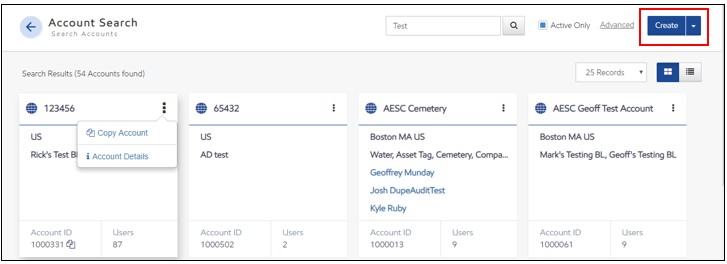
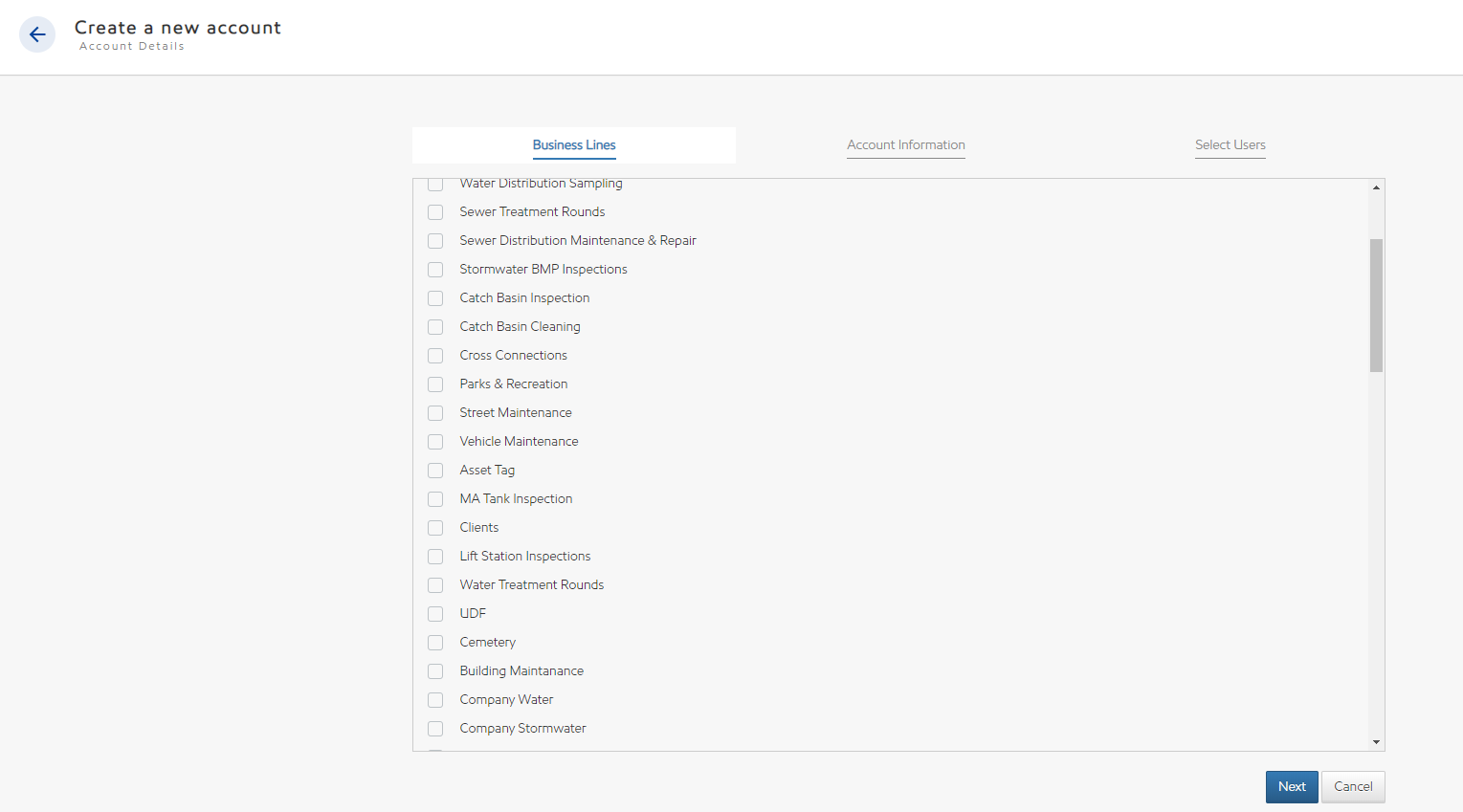
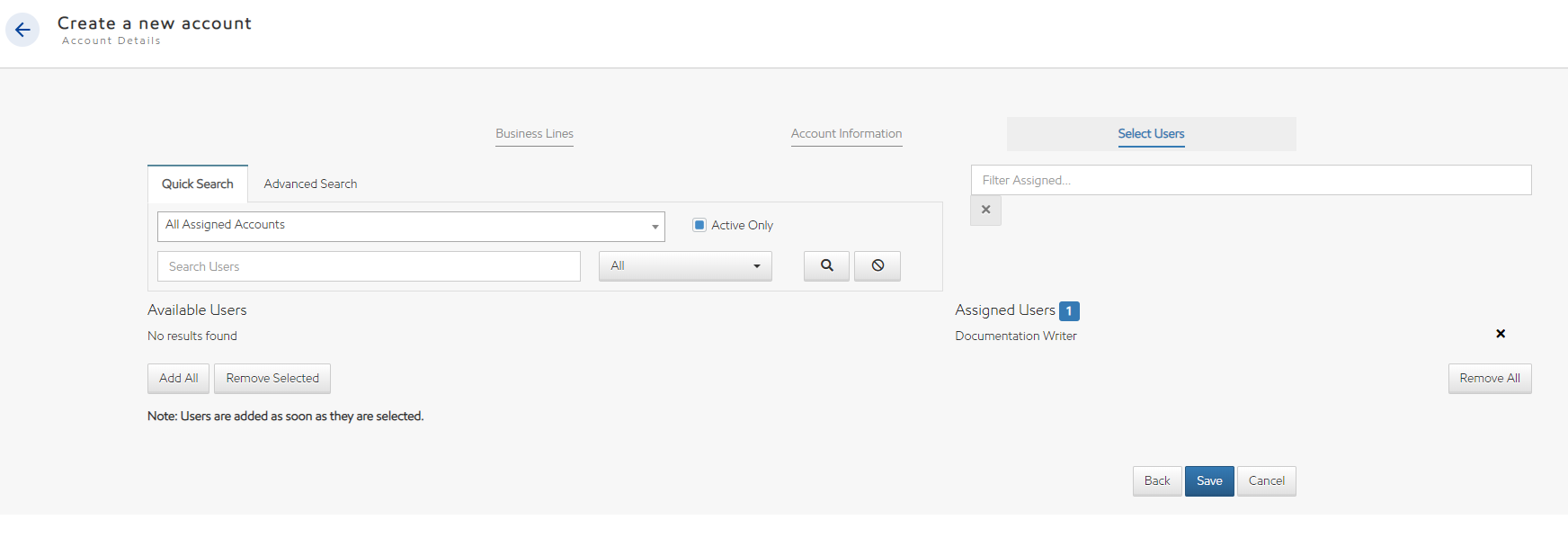
- Select the Account tile from the Landing Page or from the quick navigation menu.
- Select Create.
- The Create a new account wizard appears.
- Select a Business Line and select Next.
- Enter Account information and select Next.
- Add Users and select Next.
- Select Save.
Note: The user creating the account is automatically added as an assigned user.
Security Rights Required: View Accounts; Create Accounts
Details to Create an Account
When you select Create on the Account Search page, you are brought to the Create a new account wizard.
Complete the wizard using the following information as guidance:
- Profile:
- Account Name: Required Field; enter the name of the account or utility
- Parent Account: Choose parent account if the account is a child to another account
- Country: Required Field; Select Country
- Address: Full address, Street, (City, State and Zip Code are required for US addresses).
- Users: Search for, add, remove users from this account
- Timeline: Notes can be placed on the account. Images, file attachments, and links can also be added
- Child Accounts: View the child accounts, with an export option (with the right)
- Business Lines: Define Asset Classes and Workflows to be accessed by this account
- Stakeholders: When a user is defined as a stakeholder on the account, asset class, asset, and workflow or work schedule, that user receives emails, messages, etc. related to that account
- Reporting: Utility Cloud uses a custom API to connect to Google Sheets. In order to generate custom reports a valid google account needs to be set up. See Reporting and analytics for additional information on generating reports
Search for an Account
Quick Steps to Search for Accounts
- Select the Account tile from the Landing Page or from the quick navigation menu.
- Enter search criteria in the Search Accounts and text box type in the search criteria.
- Select Search.
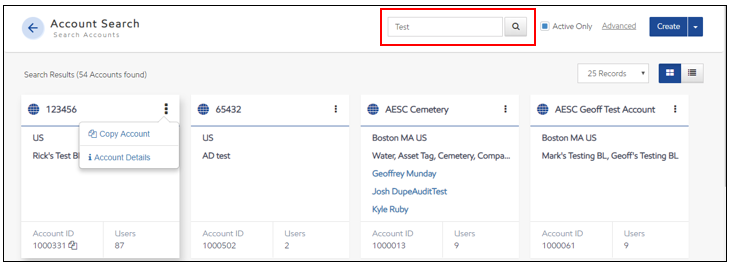
Security Rights Required: View Accounts
Advanced Search for Accounts
Advanced search allows you to create simple or multi-attribute search criteria. Advanced search allows you to combine keywords with operators such as AND and OR to produce more relevant results. Depending on the field criteria selected, additional options become available: equal, not equal to, begins with, doesn't begin with, contains, doesn't contain, ends with, doesn't end with, is empty, is not empty.
Using the Add rule or Add group of rules buttons allow you to further drill further specify the search.
For Example: search for the Accounts in any Business Line with "Maint' in the name AND who have a Stakeholder with "Smith" in the name.

To save a search, select Save and choose Save As to name the search.
To use a saved search, select the Saved Search drop-down and select the desired search to run.

Edit an Account
Quick Steps to Edit an Account
- Select the Account tile from the Landing Page or from the quick navigation menu.
- Search for the Account to Edit.
- Select Account from the results to access the Account Profile page.
- Select the Pencil Icon to Edit information in the section. (hover over the upper right hand corner to display the icon). Each section is editable independently.
- Enter or update the Account information.
- Select Save.
Note: When you change the parent account for a child, you are automatically directed to update the users associated with the account.
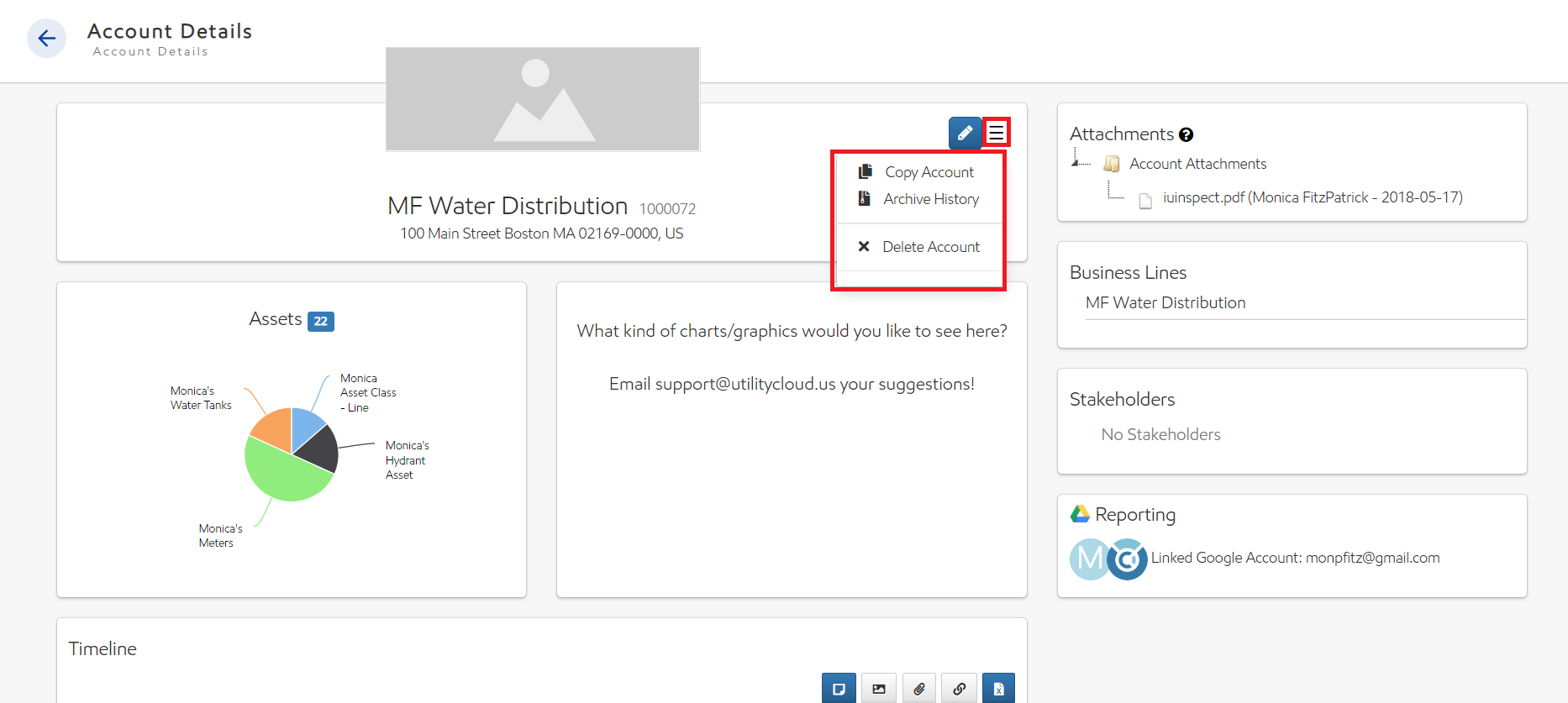
Security Rights Required: View Account; Edit Account
Copy an Account
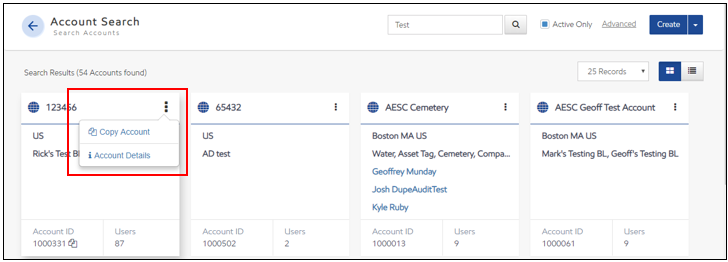
Quick Steps to Copy an Account
- Select the Account tile from the Landing Page or from the quick navigation menu.
- Select the Account to Copy.
OR
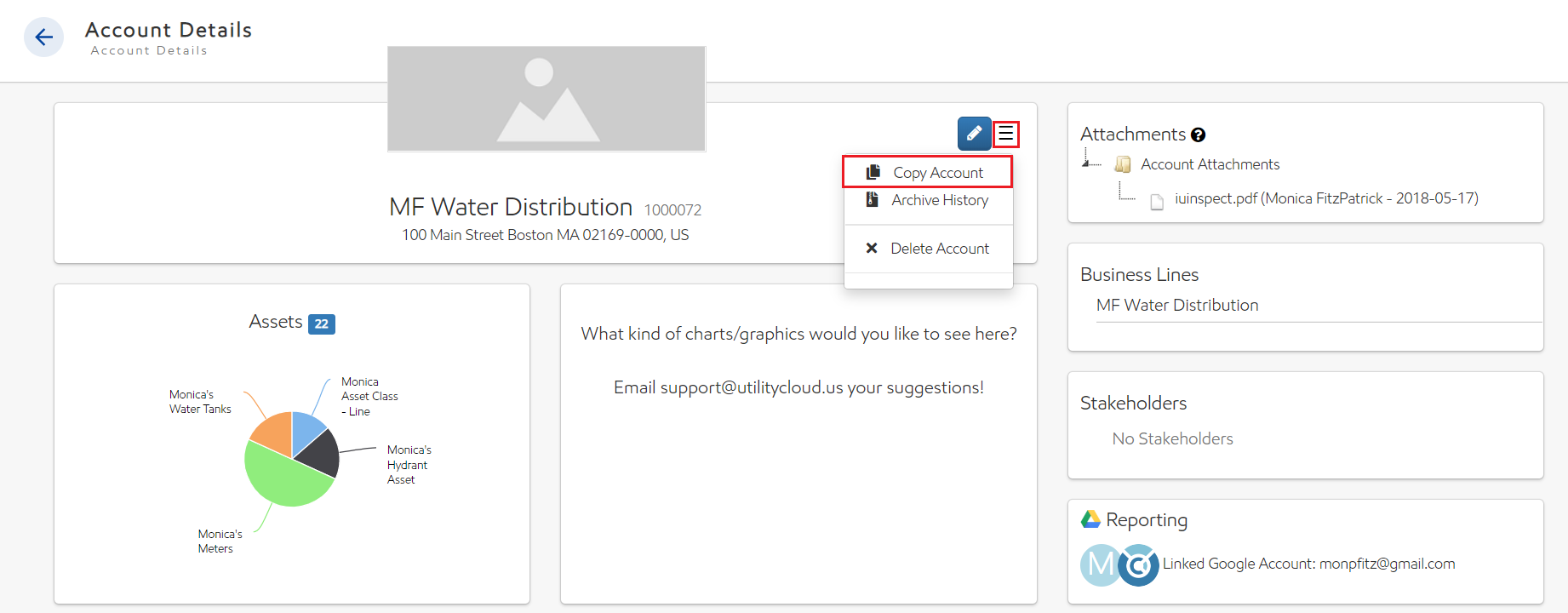
- From the Account Details page, select the menu icon and select Copy Account.
- The Create a new account wizard appears.
- Follow the wizard to:
- Select a Business Line
- Enter account profile information
- Select users and assets to copy.
- Once new information has been entered, select Save.
Security Rights Required: View Accounts; Edit Accounts
Detailed Steps to Copy an Account
- To create an account that is similar to an existing account, simply copy the existing account. This copies the basic information (address, business line, stakeholder(s), etc.) from the existing account to the new one, so all the information does not have to be entered again.
- To copy an account, select the account from the list, and select Copy Account from the Account Search or Details screen. The Create a new account wizard appears. The following required fields are not copied over for the new account:
- Account Name
- Account ID
- Enter these required fields, and update any additional information that is no longer accurate in the categories within the wizard.
- Select Save to create the copied account.
Importing Accounts
Quick Steps to Import Accounts

- Select the Account tile from the Landing Page or from the quick navigation menu.
- Select the down arrow button on the Account Search screen then select Import.
- Import the file into Utility Cloud. See the steps below for creating the import file.
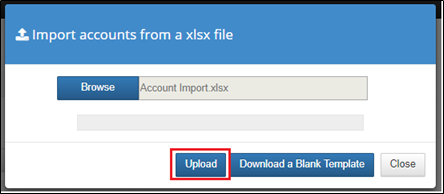
Detailed Steps to the Importing Accounts
- Select the Account tile from the Landing Page or from the quick navigation menu.
- Select the down arrow button on the Account Search screen then select Import.
- Select the Download a Blank Template option
- Save the template to your environment
- Open the template in Microsoft Excel and fill in the details
- Upload the file by dragging the file into the box or attach the file by browsing through the Choose Files button.
- Warning: Importing is limited to a maximum file size of 5000 rows. If you have more than 5000 assets to import, divide your file into two or more files.
- If the information was correctly formatted in the spreadsheet, the account will be added/ updated in Utility Cloud.
- If the information was incorrectly formatted, the import will fail. An error log is emailed or can be downloaded from the Landing Page.
- Select the file name to view the error report. Fix all errors and repeat import until successful.
Security Rights Required: View Accounts; Edit Accounts, Import Accounts
Detailed Notes to Import Fields
- New Path: You can export a current account listing, for example, and create a new parent account for the exported account(s), by entering the new parent and its information on the sheet separately, and then define a path for the children accounts in their "New Path" column using the format of: "Parent Account! Child Account"; Place an exclamation point "!" between the Parent and Child Account, and the system will import the accounts along with their relationships automatically.
- Original Path: To update existing accounts
- Account Name (Required): Enter a unique Account Name for each new account. The Account Name must be 100 characters or less.
- Account ID: If assigning account IDs to accounts, enter a unique ID for each account.
- Is Active: Enter 'Y' for yes, or 'N' for no. Must enter 'Y' for a new account.
- Address Country (Required): Must abbreviate the country using the proper two letter .NET country code. Please see Country Code Listing for a full list of countries preceded by their two letter abbreviations. If the account is located in the US, you must correctly enter the Address using the proper format outlined below, as the information will be validated
- Address must be entered on separate lines:
- For example: For a United States address you would enter the information as follows: Address 1 = 123 Main St Suite 101, Address 2 = City (i.e. Boston), Address 3 = State Abbreviation (i.e. MA), Address 4 = Zip Code (i.e. 02110).
- Phone: Enter the entire phone number including the area code.
- Phone Extension: If there is an extension associated with the Phone number, please enter it here.
- Business Lines (Required): Enter the Business Lines associated with the account as they appear in Utility Cloud. Enter multiple Business Lines with a "+" plus sign between each Business Line. For example: Water+Cross Connection.
- Stakeholder Email (Stakeholder Role): Enter each stakeholder in the format of email address (stake holder type). Enter multiple Stakeholders with a plus sign "+" between each. For example : test.userA@abccorp.com(Asset Owner)+test.userB@xyzcorp.com(Asset Owner)
- Google Email: Enter google email (used for custom reports)
- Google Password: Enter google email password (used for custom reports)
Addressing Import Errors
The following is a list of all of the possible error reports and how to resolve the issues:
- Account already exists: (See below)
- Account name already in use: If you have entered an Account name that is already being used, you will need to enter a new Account name as it is not possible to have two accounts using the same name.
- Account ID is required: Enter an Account ID
- Account ID already in use: Ensure that each Account ID is unique.
- Name is required: Enter the Account name
- Account Name cannot be longer than 100 characters in length: You must shorten the Account name to 100 characters or less.
- The account name may not contain the '!' character: Account names may not contain exclamation points as this is how Parent/Child Relationships are defined in the Upload.
- Comments cannot be longer than 3000 characters in length
- The path must end with the account name: The path should contain from left to right the parent and then the child. For example: Parent Account Name! Child Account Name. Then the Account name in the “account name” column should always be the last account in the New path columns (in this example, the account name needs to be "Child Account Name".
- Only one primary phone number is allowed: Only one phone number should be indicated as primary
- Only one primary fax number is allowed: Only one fax number should be indicated as primary
- At least one Business Line is required: Enter a Business Line
- The business line 'business line name here' does not exist: The name of the Business Line must be entered exactly as it appears in Utility Cloud.
- Country is required: Enter a country code
- Country 'country code here' is invalid: Enter the country code in the correct format.
- Street is missing for Primary address: Enter street address in Address 1
- City is missing for Primary address: Enter city in Address 2
- State is missing for Primary address: Enter state in Address 3
- State is invalid for Primary address: Enter a valid state code in Address 3
- Zip is missing for Primary address: Enter zip code in Address 4
- Zip is invalid for Primary address: Zip codes should be in the form '00000' or '00000-0000'. Enter valid zip code in Address 4
- Address Country is missing for Primary address: Enter a valid country code for the address
- Phone Type is invalid for 'phone number here': You must enter a phone type for the phone number (Phone or Fax)
- The stakeholder 'stakeholder email here' does not exist: Enter a valid stakeholder email
- Parent account does not exist: Enter a valid parent account in the path
- Import file contains duplicate Account Names - 'account name here': Ensure there is only one entry for the specified account
- Import file contains more than 5000 rows: Divide your file into multiple files with less than 5000 rows in each
Exporting Accounts
Quick Steps to Export an Account
- Select the Accounts tile from the Landing Page or from the quick navigation menu.
- Select the down arrow button on the Account Search screen then select Export.
- Note: The results of the most recent search are selected for export.
- Confirm you want to export the accounts by selecting Submit.
- The system generates an xlsx file containing the export results.
Viewing Account Relationships
Quick Steps to View Account Relationships
- Select the Accounts tile from the Landing Page or from the quick navigation menu.
- Search for the Account. Select the account by selecting the account card.
- If the account has a parent, it is visible in the main panel; if the account has children, there is a Child Accounts panel.
- Changes can be made on the Details Tab.
Detailed Information on Account Relationships
Utility Cloud gives you the ability to view all of the parent/child account relationships via an account details tab. With the appropriate permissions, you can also export an existing account and then import the changes to create a parent/child relationship among accounts.
Changing an account parent
- When you change the parent account for a child, you are automatically directed to update the users associated with the account.
- From the Update Account Information window, when you select Save, and when you have changed the Parent Account field, the Search for and add users window appears.
- You can update the users and select Save, or select Cancel to exit without updating the account users.
